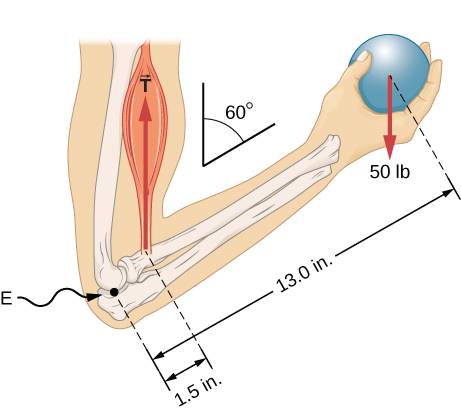15 Human Dimensions
Height (Length)
Height is a common body measurement typically measured in feet (ft) + inches (in) in the United States and centimeters (cm) elsewhere. These are length measurements, so the SI unit would be meters. Keep in mind that x feet + y inches is commonly denoted as x‘ y“.
Reinforcement Activity
Given that there are 2.54 cm in one inch, 12 in per one ft, and 100 cm in 1 m, use the chain link method to convert your height from the type of units you are familiar with into the other two types (cm, m, or ft + in).
Range of Motion
Range of motion is a common body measurement, especially while diagnosing injury or disease, tracking progress during physical therapy, or working to improve flexibility or form. Range of motion is often defined as an angle measured in degrees (°)through which a joint moves away from a reference position as seen in this video demonstration of how to use a goniometer for range of motion measurement.
For example, in the image below the joint angle is 60° and the reference position is a nearly horizontal forearm creating a 90° between the bicep muscle and the bones of the forearm. (This is not necessarily how the reference angle is defined for measuring elbow range of motion by health professionals)

At times we might want to know how far something moves as it travels through an angle. For example, as the arm in the image below moved from 90° to 60° what distance did the hand and ball cover? In such cases, and many others, working with angles in radians (rads) can be helpful. We can convert between degrees and radians using the conversion factor:
(1) ![]()
For example, in moving from 90° to the 60° seen in the previous diagram, the lower arm traversed 30° so we can convert this to radians:
![]()
The distance we are trying to calculate is known as the arc length, and to find it we multiply the angle in units of radians by the distance from the rotation point (also known as the radius). The symbols commonly used for arc length, angle and radius are: ![]() ,
, ![]() , and
, and ![]() so in our example we will have:
so in our example we will have:
![]()
We have found that the hand moves a distance of 6.8 inches when the forearm moves from horizontal to 60° of flexion. We have also discovered that rads are a placeholder unit, meaning that when rads gets multiplied by another unit, rads doesn’t necessarily show up in the final units. Finally, we realize that we need to start keeping track of which symbols are most commonly used for which quantities. The following table shows the symbols most often used for some of the common quantities that we will encounter in this textbook. As we introduce new quantities going forward we will provide the common symbol in parenthesis when the quantity is first introduced.
| Quantity | Most Commonly Used Symbol |
| Time | t |
| Length/width/distance/height/radius | l/w/d/h/r |
| Speed | v |
| Acceleration | a |
| Angle | θ |
| Area | A |
| Volume | V |
| Mass | m |
| Density | ρ |
| Force | F |
| Torque | |
| Work | W |
| Mechanical Energy/Internal Energy/Heat | E/U/Q |
| Power | P |
| Momentum | |
| Temperature | T |
| Entropy | S |
Reinforcement Activity
Measure the distance from your knee to your heel. How far does your heel actually move when the angle of your knee joint goes from 0° (straight leg) to 90°?
- OpenStax University Physics, University Physics Volume 1. OpenStax CNX. Jul 11, 2018 http://cnx.org/contents/d50f6e32-0fda-46ef-a362-9bd36ca7c97d@10.18 ↵
a unit of angle, equal to an angle at the center of a circle that produces an arc length equal to the radius

